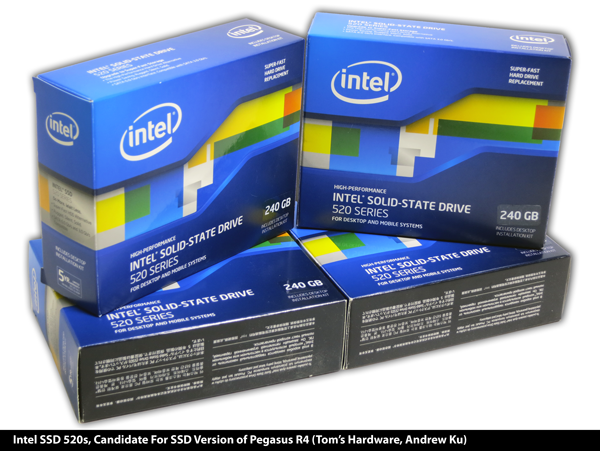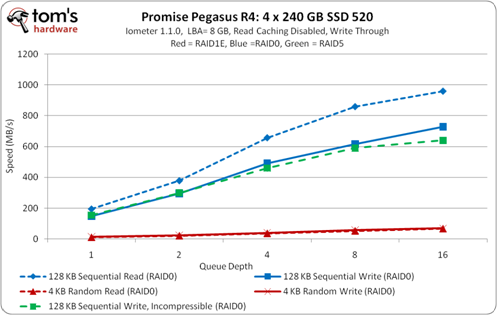Nine External Thunderbolt Storage Devices, Rounded Up
Preview: Promise Pegasus R4 (SSD Version)
Promise plans to release an SSD-based version of the R4, but has not yet decided on a specific drive model to use yet. We are told that Intel's 240 GB SSD 520 is a strong contender due to the company’s stellar reputation for reliability and the zippy performance delivered by SandForce's second-generation controller.
Promise does not anticipate selling an SSD-based R6, stating the added cost of six SSDs would would push the price of the R6 beyond what the market will bear. We don't have an estimate for what the R4 with solid-state storage will cost, either, so we were forced to create our own estimate. Using the current 4 TB R4 as a baseline, we assume the 1 TB Hitachi 7K1000.D Deskstar hard drives are about $100 each, with the chassis and components totaling about $750. A single 240 GB Intel SSD 520 runs just north of $300, so a four-SSD variant of the current R4 could conceivably weigh in under $2000.
What this quad-SSD R4 variant might offer will depend on what you compare it to. Next to the R6, its benefits are likely to be limited. In theory, sequential performance should speed up by 5-10% (50-100 MB/s), while random I/O improves by an order of magnitude. Achieving better random throughput is important for certain applications that a hard drive-based solution simply cannot address. However, LaCie's Little Big Disk is more effective with its two SSD 320s than Promise's R4 armed with four SSD 520s when it comes to random performance.
The SSD-based R4's throughput matches what you can achieve using a hard drive-based R6. However, that performance gain costs lots of capacity. Even sporting 240 GB drives, the R4 tops out under 1 TB of space. That's nowhere near enough room for data-dense multimedia applications that chew up multiple terabytes.
Perhaps the characteristics of solid-state storage make this particular R4 more attractive, though. If you have production equipment operating in a vehicle, for example, or are constantly moving drives from one place to another, SSDs prove far more resilient against physical shock. They also run a lot cooler and use a lot less power.
Get Tom's Hardware's best news and in-depth reviews, straight to your inbox.
Current page: Preview: Promise Pegasus R4 (SSD Version)
Prev Page Promise Pegasus R4 8 TB Next Page Seagate GoFlex Desk Thunderbolt 3 TB-
acku Reply9535164 said:No benchmark for 8-drive Thunderbolt deivces such as Areca ARC-8050 ?
What the R6 isn't expensive enough? :p Honestly, we couldn't include the ARC-8050 (http://www.areca.com.tw/products/thunderbolt.htm) because it's not readily available for purchase (yet).
Cheers,
Andrew Ku
TomsHardware.com -
mayankleoboy1 storage is OK, but an externally powered GPU is the most interesting application of thunderbolt.Reply
with the external PCI-E device specification coming soon, i believe the days of thunderbolt are limited. -
web2dot0 mayankleoboy1storage is OK, but an externally powered GPU is the most interesting application of thunderbolt.with the external PCI-E device specification coming soon, i believe the days of thunderbolt are limited.Reply
Thunderbolt IS ePCI-E. Well, using Intel's implementation. You think the specification will somehow make things cheaper? Nope. -
chovav Thank you Andrew for this review, it certainly makes it clear whether you should invest in thunderbolt or not.Reply
Could you maybe do add a random read/write graph comparing GoFlex Desk with USB3 and Thunderbolt?
I was also wondering what the CPU usage is during read/write - is there any impact at all? or does the thunderbolt controller bear all the processing grunt-work?
Thanks again, great article. -
CaedenV web2dot0Thunderbolt IS ePCI-E. Well, using Intel's implementation. You think the specification will somehow make things cheaper? Nope.thunderbolt is a medium that allows for multiple interconnect protocols to be transmitted over the same wire. It can send PCIe, it can send DP, it was supposed to be able to send USB 1/2/3, as well as Ethernet, all over the same wire... but we have not seen that happen over the copper version that was released.Reply
The external PCIe will be cheaper and easier because it will be hosted directly by the mobo chipset, or the CPU by tapping into already existing hardware. Chip makers will not have to add a new and expensive tech to the device, the connection will just siphon off lanes that are already there. And because it is already standardized and cheap technology it will be easier and cheaper to implement. Finally it will be an open standard that multiple manufacturers can adopt. Thunderbolt (as much as I love the idea) is made and operated by Intel, and Intel wants to charge a premium for it. Until there are multiple chip makers who can make it, then it will continue to be too expensive... and when multiple chip makers can make it then Intel will be the only one worth buying (much like their network interfaces) because nobody can do quality like intel, but at least the price will come down. -
mayankleoboy1 ^ like the Marvell SATA controllers.Reply
And thunderbolt is not going optical fibre in the coming years. the cable is too expensive and cant carry much power.
and the fact that apple is using it gives some clues about its price, compatibility, usability and openness.
i remember how TB was promoted : one single wire from your PC to a TB brick. and from that brick you added USB, ethernet, firewire, DP, HDMI. basically it was touted as "1 wire for everything". supposed to be magical, and we all know how that turns out.
-
acku CaedenVthunderbolt is a medium that allows for multiple interconnect protocols to be transmitted over the same wire. It can send PCIe, it can send DP, it was supposed to be able to send USB 1/2/3, as well as Ethernet, all over the same wire... but we have not seen that happen over the copper version that was released.The external PCIe will be cheaper and easier because it will be hosted directly by the mobo chipset, or the CPU by tapping into already existing hardware. Chip makers will not have to add a new and expensive tech to the device, the connection will just siphon off lanes that are already there. And because it is already standardized and cheap technology it will be easier and cheaper to implement. Finally it will be an open standard that multiple manufacturers can adopt. Thunderbolt (as much as I love the idea) is made and operated by Intel, and Intel wants to charge a premium for it. Until there are multiple chip makers who can make it, then it will continue to be too expensive... and when multiple chip makers can make it then Intel will be the only one worth buying (much like their network interfaces) because nobody can do quality like intel, but at least the price will come down.Reply
Read http://www.tomshardware.com/reviews/thunderbolt-performance-z77a-gd80,3205.html Thunderbolt can externalize anything. It just has to have the controller. It is external PCIe. External USB 3.0 and ethernet are possible but unlikely because they are already on the mobo.
From a practical standpoint, external PCIe may cheaper, but it's pointless from a performance standpoint http://en.wikipedia.org/wiki/PCI_Express#External_PCIe_cards. Everything is limited to a PCIe 1.0 x1 connection. The new ExpressCard standard (v2.0) ups bandwidth to slightly more than PCIe 1.0 x2, which still isn't that fast compared to TB (PCIe 2.0 x4 uplink). Plus ExpressCard only lets you connect a single device. It's one and done after that. For a mobile user, Thunderbolt is the way to go. Worse, you can't count on EC to be available. I'm already seeing Ultrabooks with TB. It makes sense because it doesn't require a lot of space. EC requires more space, hence it will be a greater rarity now that TB is out.
It looks expensive now but be patient. TB is something you will want. Many people need to look past the role Apple played. It clearly is a performance oriented technology that opens up a whole new world, especially on the mobile side.
Cheers,
Andrew Ku
Tom's Hardware.com
-
web2dot0 CaedenVthunderbolt is a medium that allows for multiple interconnect protocols to be transmitted over the same wire. It can send PCIe, it can send DP, it was supposed to be able to send USB 1/2/3, as well as Ethernet, all over the same wire... but we have not seen that happen over the copper version that was released.The external PCIe will be cheaper and easier because it will be hosted directly by the mobo chipset, or the CPU by tapping into already existing hardware. Chip makers will not have to add a new and expensive tech to the device, the connection will just siphon off lanes that are already there. And because it is already standardized and cheap technology it will be easier and cheaper to implement. Finally it will be an open standard that multiple manufacturers can adopt. Thunderbolt (as much as I love the idea) is made and operated by Intel, and Intel wants to charge a premium for it. Until there are multiple chip makers who can make it, then it will continue to be too expensive... and when multiple chip makers can make it then Intel will be the only one worth buying (much like their network interfaces) because nobody can do quality like intel, but at least the price will come down.Reply
Thank you for your Wikipedia quote. Everybody can quote from the spec sheet. The trouble is you make it seem like Intel are bunch of morons building a interconnect that nobody uses. That's is plain wrong. Just like SSDs, they will come down in price and next thing you know, you'll be asking yourself why in the world would I not use Thunderbolt. Imagine running a external GPU on your Retina Display MacbookPro when you dock your laptop. There'll be a lineup of people buying that technology at a premium price.
Partnering with Apple is no accident. 2 giant corporations backing the initiative is nothing to sneeze at. Give it a few years, and you'll soon find out the true power of Thunderbolt. USB 3.0 complements Thunderbolt.

